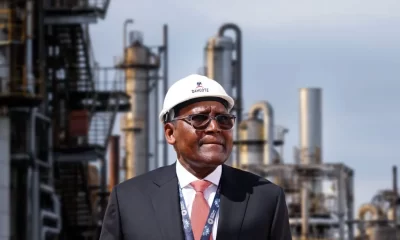Column
The ‘Hushpuppi’ Syndrome In Nigeria

The entire Nigerian system has been hushpuppified and we all are playing the ostrich. You want to know how? Then take a few minutes to distill this piece.
Nigerian influencer, Ramon Abbas, aka Hushpuppi was recently arrested in Dubai and taken to stand trial in the US on charges bordering on Internet fraud and money laundering. His case has become the metaphor for every wrong thing plaguing the society which is a direct reaction to our collective actions as leaders and followers in this society.
Leaders are either completely oblivious of what to do to re-engineer society for good or (where they know) prefer to look the other way and not act because they think that by their amount of loot they would be immune to the terminal disease plaguing the society which is sure to kill the society. Followers, on the other hand, are either too fearful, poor, stupid or just naive to follow through with what they are supposed to do to make society better.
Take the following few instances among the very many others highlighted below that are classical symptoms of a very gangrenous hushpuppified society:
Bank owners and bank managers send young ladies and married women to go and seek deposits at ‘all cost’, even if it meant selling their bodies to potential customers. The sad news is that after doing that, the customers will still remain the real owners of the monies, the bank owners and managers would only give these deposits to the extremely rich and powerful among us in the society as loans at the expense of building the real sector and the SMEs.
These ladies would not be able to influence the dispensing of such sums as loans to their struggling husbands, friends or relatives who are seriously in need of the monies for one form of development endeavour or another capable of improving the real sector in the society. The bank ladies would at best be promoted, in very rare cases, and some made to repeat this cycle continuously without promotions or even any real gains or value coming to the country.
Lecturers would demand sex for marks from female students and money for marks from male students and, sometimes, money and sex from female students to ‘pass’ them into the society as graduates to come and practice what they are completely unaware of, and untrained for, without bothering or considering the impact on the society.
The police will take bribes from the ‘big men’ in the society to go and arrest an accused (often innocent) without proper investigation and damn the consequences of what those actions might have on the law enforcement and the psyche of the society. They would stand on the road to collect monies from riders of commercial motorcyclists and motorists who constitute themselves as risks to other road users or who are just struggling to earn a living without considering the impacts of their actions on the society.
Pastors and imams would insist that members pay tithes, sow seeds and offerings, and often, the ‘quality’ of such offerings, is directly proportional to their levels and degrees of recognition in the church. This is done without considering the impact of their actions on the society. They even give some of these so-called ‘givers’ awards and recognition of best partners even though they are very much aware that these individuals have no real jobs but are just thieves, 419ers, dupes and Internet fraudsters stealing from innocent people in the society through their various evil schemes.
Parents do not ask but celebrate their teenage sons and daughters yet to leave secondary school, who are already spending money on expensive properties and lifestyles without asking where they got such monies. Even though they are aware that those children do not have qualifications or skills to even do any job that can pay them as little as N30,000 a month, most parents are still comfortable celebrating those children, ignoring the consequences of their action on the other children and the society.
Politicians are busy thieving, stealing, laundering and ‘eating’ public money entrusted into their care by the people, not doing anything near real development of the people and the society for the four to eight-year period they are in office. They come out eventually from office and establish some ‘evil’ pension laws for themselves that would make them continue with the stealing of the commonwealth of the people without considering the impacts of their actions on the treasury and the society.
Citizens collect paltry sums of money or wrappers and bags of rice to sell their votes and turn back to pray for God to touch the hearts of their benefactor politicians to do good for the society without understanding the consequences of their actions on the society.
University professors rig illiterates and verified Agberos into offices and every year they (as ASUU members) keep going on strike seeking for better working conditions and improvement of the university system from the same clueless people without understanding the full weight and consequences of their action on the society.
Young girls step out of their homes dressed for school and other public places without wearing bra, thus literally exposing their bodies and nipples as if to say ‘I am available, you can come and take it’. They do this rubbish and more because society has become so numb and perverted that nobody or only very few tell them how profane their dress sense is.
Nigerians only celebrate and share posts of those who expose and flaunt nudity on social media, skimming and passing by very meaningful posts without liking, sharing or commenting on them simply because there is no ‘vain value’ attached to them.
Do not even get me started on the health sector in Nigeria. The doctors, nurses, laboratory scientists, Health Maintenance Organisations, National Health Insurance Scheme, the patients and even the corporate organisations. Hmmm… let me hold my peace here for now on this
A society where politics is more profitable than industry, and where developmental discoveries and copyrights cannot guarantee one’s daily bread because of the actions and inactions of our leaders, nay dealers, is one that would remain hushpuppified for a long time.
By: Andy Akpotive
Akpotive wrote from Port Harcourt.
Column
Are the Bears Wrong About the Looming Glut in Oil?

Column
Renewable Energy Faces Looming Workforce Crisis

Column
Is It End For Lithium’s Reign As Battery King?

-

 Politics1 day ago
Politics1 day agoSenate Receives Tinubu’s 2026-2028 MTEF/FSP For Approval
-

 News1 day ago
News1 day agoDangote Unveils N100bn Education Fund For Nigerian Students
-

 News1 day ago
News1 day agoRSG Lists Key Areas of 2026 Budget
-

 News1 day ago
News1 day agoTinubu Opens Bodo-Bonny Road …Fubara Expresses Gratitude
-
News1 day ago
Nigeria Tops Countries Ignoring Judgements -ECOWAS Court
-

 Featured1 day ago
Featured1 day agoFubara Restates Commitment To Peace, Development …Commissions 10.7km Egbeda–Omerelu Road
-

 Sports1 day ago
Sports1 day agoNew W.White Cup: GSS Elekahia Emerged Champions
-
News1 day ago
FG Launches Africa’s First Gas Trading Market, Licenses JEX

